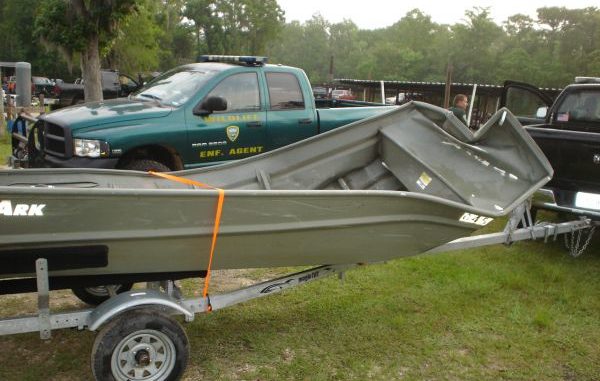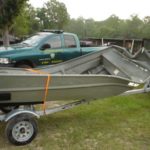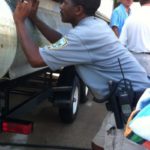
Err on the side of caution
On a hot July Saturday some years ago, a group of friends launched their boats on Red River for an afternoon of fun on the water. They travelled upriver to a sandbar just north of a port and barge-mooring location on the Red.
The sandbar was similar to a beach, and was a common meeting point for recreational boating regulars frequenting the river. It was a nice place to beach the boat and fire up the grill for a riverside picnic.
Some of the local boaters used the sandbar as an overnight camp spot, and this group had plans to camp till Sunday.
While they were enjoying the afternoon, a tugboat came upriver and pushed a tow of barges into the mooring location near the port. Both the mooring location and port lie on the right descending (west) bank of the river. The barges were properly moored and anchor lights (white lights visible from 360 degrees) were placed at the correct locations. The tugboat tied up at the port for the night.
Darkness fell.
An hour or so after dark, the group on the sandbar decided to turn in for the night. But as the night wore on, the breeze along the river faded away. Clouds of mosquitoes descended on the group and quickly changed their minds about remaining overnight.
Six people — two women and four men — were in the party. A husband and wife were in their boat, a small bateau with a tiller drive outboard. The other four were in a larger boat of 20 feet in length or so. It was of a speed hull design and equipped with a big outboard.
The members of the party woke up the operator of the larger boat; they wanted to go home.
He had been drinking during the afternoon and evening prior to going to sleep. But his level of intoxication at the time he was roused from sleep remains subject to speculation.
He and his three passengers got in his boat and prepared to go downriver to the public boat launch. The husband and wife prepared to follow in their bateau.
No one knew about the barges arriving and mooring by the port.
According to the bateau operator, the plan was to proceed downriver at idle or slow speed, since neither of them had a spot or searchlight.
But apparently someone in the larger boat became impatient, and the operator hit the gas, put the boat up on plane and took off.
It was last seen going around the bend toward the port in total darkness.
The bateau driver prudently continued to idle along.
He was doing just that when he heard an impact followed by silence.
Motoring up to the port, he cut the engine, looking and listening. He heard a weak cry for help over near the moored barges, cranked the outboard and went in that direction.
Near the end of the last barge in line he found two passengers from the first boat. Neither of them was wearing a PFD. They were seriously injured and struggling desperately to stay afloat in the river.
The speedboat, operator and woman passenger were nowhere to be seen.
The husband and wife pulled the two men from the water, no doubt saving them from drowning. The injured men said they were speeding along when the boat suddenly slammed into something (turned out to be the side of the barge).
They were ejected from the boat, apparently missing a potentially fatal collision with the barge, and landed in the water.
The rescuers and injured victims went to the port for help and made contact with the crew onboard the tugboat.
First-responders from the police department, sheriff’s office and the Department of Wildlife and Fisheries Enforcement Division were soon on the scene.
Search efforts went on throughout the night, but the other two victims and the boat could not be located.
Statements were obtained from the rescuers and survivors while search efforts continued over the next few days. As the search went on, evidence was collected, distances were measured and photographs were taken.
On the following Tuesday, we recovered the bodies of the two missing victims. On Wednesday, we located the boat and raised it from the bottom of the river.
So went the initial response and investigation of this tragic double fatality. Responsibility for investigating recreational boating accidents lies with the LDWF Enforcement Division. And wildlife enforcement agents are trained extensively to conduct investigations and reconstruct accidents.
Any such accident in which people are injured or killed or property damage exceeds $200 must be reported and a boating accident report form must be completed and submitted to LDWF.
In minor accidents, nothing more is involved than completing the accident report form. It is no different than a minor fender bender in the parking lot.
But more-serious accidents often require extensive investigation in order to determine what caused the accident and who was at fault. These investigations sometimes involve looking into the background of the operator. Was he or she familiar with the body of water and the boat they were operating? Did they have a reputation as a careful and skilled boater, or did they tend to be reckless? Were they known to drink heavily or abuse other substances?
Other factors contributing to the cause of the accident must be determined. How good or well maintained was the equipment? What about time of day, visibility and weather conditions? What was the direction and speed of travel? If the accident involved a collision, could the operator or operators see what was about to be hit? Were they travelling at a safe speed for the conditions at the time and should they have been able to avoid the collision?
Recovery and examination of the boats involved is crucial to determining what happened. For example, when two boats collide it is not at all unusual for one boat to go over the top of the other, with fatal consequences for people in the overridden boat.
The boat running over is nearly always determined to have been up on plane and travelling at a higher speed.
In the accident described above, the investigation and reconstruction techniques mentioned here were used to determine what led to the death of two people and critical injury to two more.
First, we determined the operator boated on this stretch of river frequently and was familiar with it. His boat was designed for speed and he enjoyed running it fast. Witnesses reported he had been drinking that day and evening before going to sleep. As mentioned earlier no one, including him, knew of the arrival of the barges.
But none of those facts could explain why the operator had steered so near the right descending bank and directly into the side of the moored barge sitting so near the bank as to be partially grounded.
Even more odd was the fact that the point of impact on the barge was only a few feet up the length of the barge from the stern anchor light. Had the operator steered to the left of the light from his point of view in the boat, he would have missed the barge completely, possibly running aground on shore but with much better chances of surviving the grounding.
We decided to reconstruct the accident by repeating the course of travel taken by the operator before moving the moored barges and at the same time of night when the accident occurred. Upon doing so and rounding the bend in the river where the port came into view, we noticed that — looking downriver — the overhead light at the public boat launch on the left descending (east) bank was visible. By pointing the bow of the boat just to the right of the light, one could proceed downriver in the main channel at good speed until coming alongside the light and boat launch. Turn in to the launch here, and you were home.
But we also noticed, surprisingly, that downriver just beyond the port but somewhat off to the right was the stern anchor light on the barge. Both the stern light and the overhead at the launch presented small, white lights in the distance in the same direction downriver.
Did the operator in an inebriated or sleepy condition round the bend, spot the anchor light, confuse it with the boat launch light and set a course with it just off the left of his bow and speed to his death? It is only a theory, but one developed using good reconstruction techniques, and it is widely accepted by the parties involved as the cause of the accident.
The lesson to be learned from this and many other boating accident investigations is that the basic boating safety rules hold true and save lives.
Wear PFDs, boat sober, stay off the water at night. If you must travel at night go slowly, use lights and be sure of your location.
Have a safe and enjoyable boating summer.




